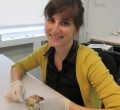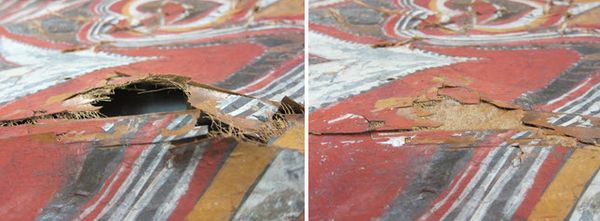Resurrected Abelam Bark Painting Returned to View
When you look up at the large, towering Abelam bark painting in our exhibition Connecting Cultures, you wouldn’t guess that it had been bedridden for the last 30 years.
After being exposed to a range of uncontrolled environments—first on the gables of a ceremonial house in tropical Papua New Guinea, then in the drier conditions of the Museum—the paint layer had become unstable, making the work too fragile to stand upright. This is due to an inherent incompatibility of materials: as humidity changes the bark expands and contracts to a greater degree than the paint, causing it to crack and separate.
Old photos in the object’s conservation folder showed it in even worse condition, with paint tenting and curling. In 1979 conservators had treated this by consolidating the work with dilute methyl cellulose, a plant-derived adhesive. While this treatment made the work stable enough for horizontal storage over 30 years ago, it was in no state for exhibition.
To complicate matters for us, the surface had grown very dusty in storage. It is tricky to clean such a fragile surface, but it must be done prior to consolidation to avoid trapping the dust.
Our secret weapon for this was available at our local drugstore: cosmetic wedges. Highly porous and super-soft, these polyurethane sponges pick up dust without damaging the loose and brittle paint.
Once the surface was clean, we began testing consolidants—adhesives to secure the paint. When introducing a new material to an art object, conservators always need to balance aesthetics with longevity. We chose a specially processed methyl cellulose that satisfied both these goals—A) it didn’t dramatically change the sheen or gloss of the surface, as many consolidants do, and B) it is known to age well with the consolidant applied in the 1970s (also a methyl cellulose). We applied it at a high concentration with an air brush, strengthening the paint layer. Then, using a tiny heated spatula, we set down lifting paint flakes – bonding them to the bark. The paint now had enough integrity to withstand the pull of gravity in a vertical orientation.
The painting had also suffered a wound: in the bottom right corner was a gaping hole. The bark around the hole was curling: we had to flatten it to effectively bridge the gap. We used Goretex—a material developed by the sports industry that is waterproof yet breathable— to gently introduce water vapor to the distorted areas. This humidification softened the bark enough to allow us to flatten it and mend the hole with a bridge of toned, archival tissue.
Now clean, much flatter, and hanging high in the galleries, the work more closely resembles its bold original incarnation. And, most importantly, it is now exhibited in a climate-controlled environment, ensuring a long-lasting bond between paint and bark.

Ellen Moody is the current graduate intern in Objects Conservation at the Brooklyn Museum. She is a third-year fellow at the Winterthur/University of Delaware Program in Art Conservation and before coming to the Museum has completed internships at a variety of other institutions, including the Metropolitan Museum, the Museum of Modern Art, the Cultural Heritage Agency of the Netherlands and the J. Paul Getty Museum in Los Angeles. She received a B.A. in Art History at Pomona College.





